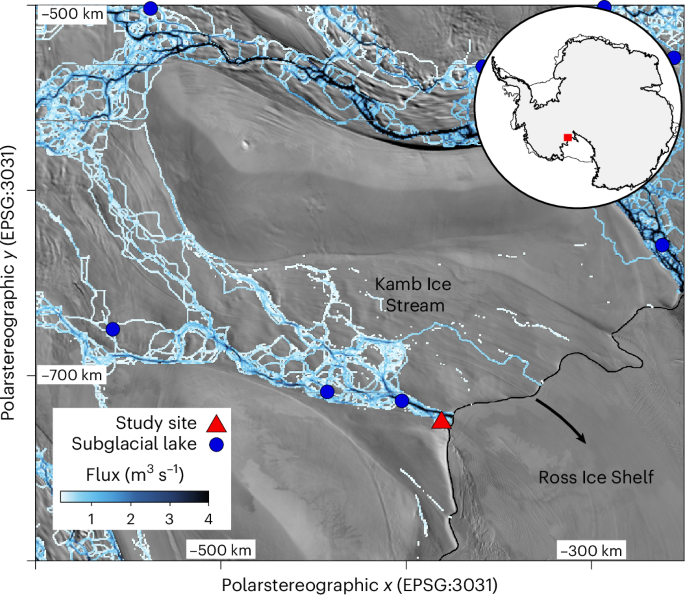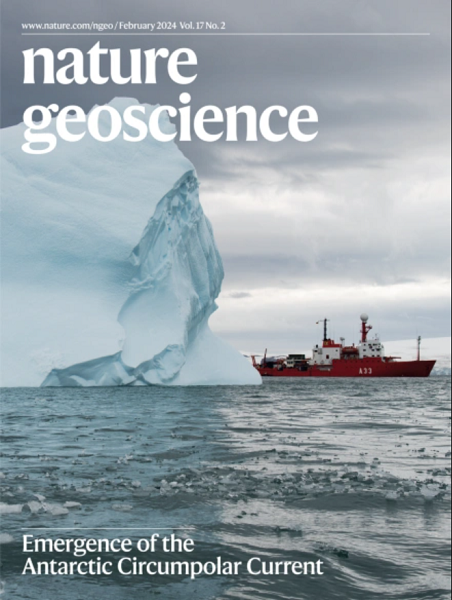由偶发水流形成的西南极洲陆基带环境
IF 16.1
1区 地球科学
Q1 GEOSCIENCES, MULTIDISCIPLINARY
引用次数: 0
摘要
在南极洲冰盖之下,一个很少被观察到的液态水网络连接着广阔的景观,并促进了覆盖在上面的冰的运动。当这些冰下的水到达冰架下的海洋空洞时,它与海水混合,扩大了融化,并在冰面底部形成了深深的沟渠。在这里,我们介绍了从热水钻孔中观察到的冰下水进入Kamb冰流和罗斯冰架地面区海洋腔的情况。我们的观测表明,融冰已经使冰层厚度减少了大约三分之一,但测量结果显示,在浑浊的羽流中,冰下流量的速率很低。从河道底部取心的沉积物显示出较大的排放事件,并从不同的地质区域偶发沉积物质。我们量化了冰下流量,并将我们的观测结果与上游集水区联系起来。我们得出结论,离散的流量事件可能主导了河道融化和沉积物运输,并导致Kamb冰流下游广泛的冰架特征。本文章由计算机程序翻译,如有差异,请以英文原文为准。


A West Antarctic grounding-zone environment shaped by episodic water flow
Beneath Antarctica’s ice sheets, a little-observed network of liquid water connects vast landscapes and contributes to the motion of the overriding ice. When this subglacial water reaches the ocean cavity beneath ice shelves, it mixes with seawater, amplifying melt and in places forming deep channels in the base of the ice. Here we present observations from a hot-water-drilled borehole documenting subglacial water entering the ocean cavity at the grounding zone of Kamb Ice Stream and the Ross Ice Shelf. Our observations show that melt has removed approximately a third of the ice thickness, yet measurements reveal low rates of subglacial discharge in a turbid plume. Sediment cored from the channel floor shows larger discharge events occur and episodically deposit material from distinct geological domains. We quantify subglacial discharge and link our observations to the catchment upstream. We conclude that discrete discharge events are likely to dominate channel melt and sediment transport and result in the extensive ice-shelf features downstream of Kamb Ice Stream. Observations from a borehole in the Kamb Ice Stream suggest that discrete subglacial discharge events dominate channel melt and sediment transport.
求助全文
通过发布文献求助,成功后即可免费获取论文全文。
去求助
来源期刊

Nature Geoscience
地学-地球科学综合
CiteScore
26.70
自引率
1.60%
发文量
187
审稿时长
3.3 months
期刊介绍:
Nature Geoscience is a monthly interdisciplinary journal that gathers top-tier research spanning Earth Sciences and related fields.
The journal covers all geoscience disciplines, including fieldwork, modeling, and theoretical studies.
Topics include atmospheric science, biogeochemistry, climate science, geobiology, geochemistry, geoinformatics, remote sensing, geology, geomagnetism, paleomagnetism, geomorphology, geophysics, glaciology, hydrology, limnology, mineralogy, oceanography, paleontology, paleoclimatology, paleoceanography, petrology, planetary science, seismology, space physics, tectonics, and volcanology.
Nature Geoscience upholds its commitment to publishing significant, high-quality Earth Sciences research through fair, rapid, and rigorous peer review, overseen by a team of full-time professional editors.
 求助内容:
求助内容: 应助结果提醒方式:
应助结果提醒方式:


